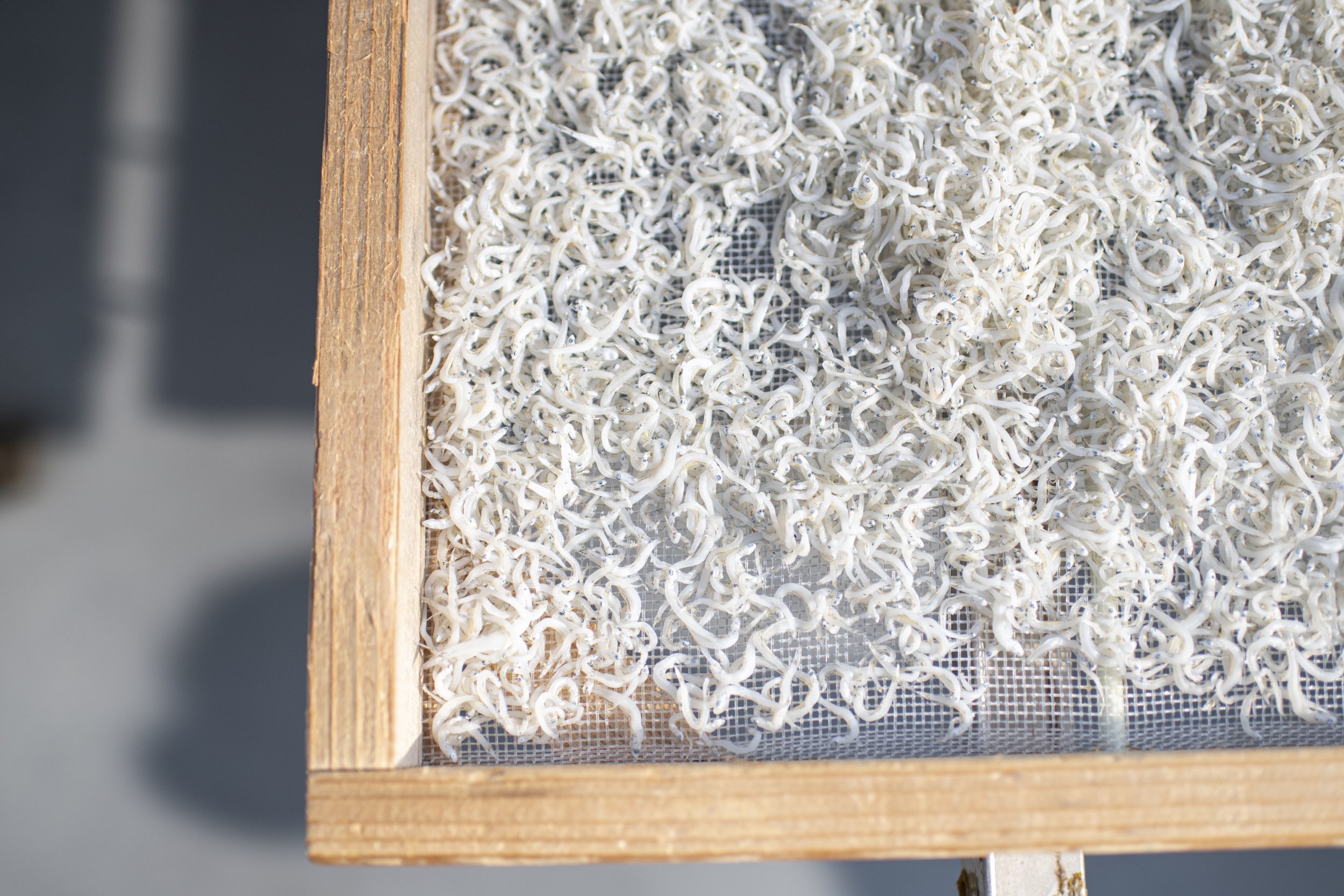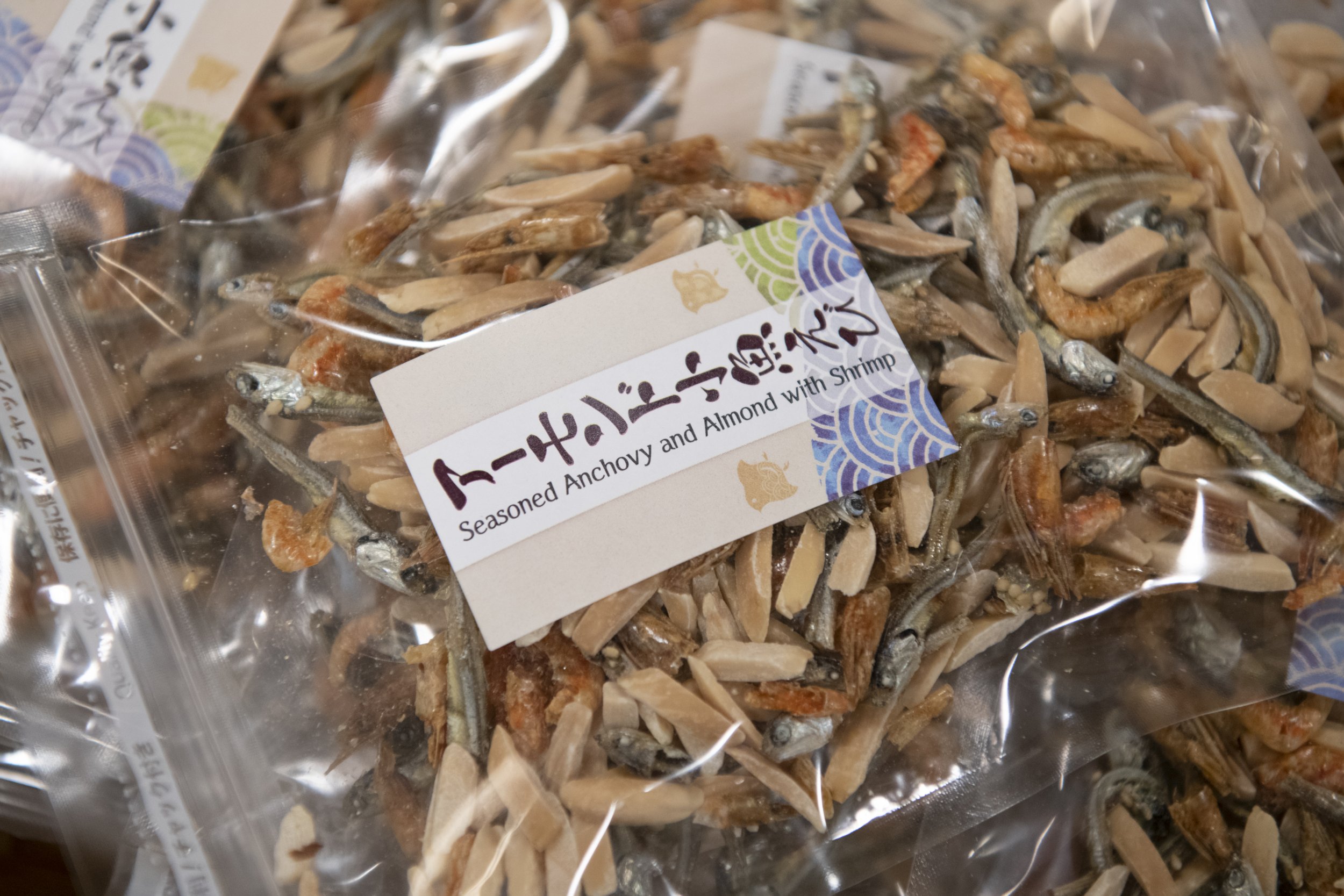Deguchi Shoten : Dried Seafood Store
Tucked away in the covered arcade of the old town of Sumoto City, the largest city on Awaji Island, Deguchi Shoten may seem like a modest, modern store at first glance. However, it holds a rich history and an esteemed reputation as a provider of premium dried seafoods that are at the heart of Setouchi cuisine. As you step inside, the inviting scent of the sea greets you, coming from boxes of dried baby anchovies and sardines known locally as iriko or as niboshi in other parts of Japan. These little dried fish are commonly used in the Setouchi region to make a robustly flavored dashi stock and come in four different sizes tailored to the desired stock strength or for use as whole ingredients in simmered dishes and as nutritious protein and calcium-rich snacks.
You'll also notice a subtle, sweet aroma wafting from bags of locally wild-caught seaweeds such as wakame, hijiki, nori, and amakusa. In addition, the store offers konbu from Hokkaido, available as thick flat pieces to make dashi stock and as finely shaved tororo-konbu to add a soft, melt-in-your-mouth texture and a mild, umami-rich flavor to soups, salads, rice dishes, and more.
Established in 1801 as a distributor and wholesaler, Deguchi Shoten opened its storefront in 1860 to cater to both home cooks and professional chefs. Today, the shop is helmed by fifth-generation owner, Masaya Deguchi, who upholds his family's long-standing tradition of sourcing products from local fishermen and ama divers. Ama divers, predominantly women, have practiced free-diving without scuba gear or oxygen tanks to collect seafood like shellfish, seaweed, and sea urchins for over 2,000 years. These skilled artisans use time-honored techniques to process their catch, such as blanching, salting, or coating it in charcoal ash, followed by drying it on the beach to preserve the fresh flavor and prolong its shelf life.
Dried seafood has been an essential part of Japanese culinary history for thousands of years, dating back to the Jomon period (14,000-300 BC). In Setouchi cooking, dried fish and seaweeds hold a special place thanks to the region's bountiful Seto Inland Sea and culinary traditions. These tasty treats serve multiple purposes, from adding umami-rich seasoning and flavor to dishes, to being used as toppings, garnishes, or simply enjoyed as snacks. Besides their delicious taste, dried seafood is highly valued for its nutritional benefits. They're packed with protein, omega-3 fatty acids, iodine, calcium, vitamins A and D, antioxidants, and yet low in calories and fat, making them very wholesome ingredients.
“Ash-Dried” Naruto Wakame Seaweed
For over twelve hundred years, Awaji Island has been renowned for its exceptional dried seafood. Among these, the wild-caught wakame seaweed from the Naruto Strait, known as Naruto Wakame, stands out as among the finest in Japan and is highly sought after by cooks across the country. At Deguchi Shoten, this prized wakame is preserved using the traditional "hai-boshi" or "ash-dried" method. The freshly caught wakame is coated in fine charcoal ash and then dried, ensuring that the seaweed's vibrant green color, delectable flavor, and satisfying texture are beautifully preserved. Moreover, this process extends its shelf life for up to two years when stored properly in a cool, dark place away from direct sunlight.
Masaya Deguchi says that many people think that it’s troublesome to rehydrate ash-dried wakame and wants to dispel that myth. In reality, it's much simpler than most people think. He assures that once you've rehydrated the seaweed, you'll appreciate its delightful oceanic flavor and plump texture. Here are his helpful tips on how to easily rehydrate ash-dried wakame:
Start by cutting the seaweed into roughly 1” (2-3 cm) pieces using scissors, making sure to do this inside the bag to avoid any mess. This way, you won't have ash scattering and staining your workspace.
Next, place the cut pieces in a colander set in a bowl of cold water. At first, the water will turn pitch black, but don't worry! After soaking the wakame for a few minutes, rinse it in the colander five or six times, and you'll notice the water becoming clearer each time.
Once your wakame is rehydrated, avoid squeezing it. Instead, let it drain naturally by standing the colander upright or using another method that allows the wakame to retain its freshness.
Finally, transfer the rehydrated wakame to a storage container and keep it in the refrigerator. You can enjoy it for several days, using it in your favorite recipes whenever you like.
Seafood Delicacies
Deguchi Shoten also serves as a marine delicatessen, showcasing semi-dried baby anchovies and sardines called chirimen, available as they are or simmered in soy sauce with spicy sansho berries for a dish called chirimen sansho. You can find hijiki prepared as hijiki tsukudani, which is hijiki seaweed cooked in a rich, ginger-infused, salty-sweet sauce, and a kind of trail mix of dried baby anchovies and tiny peeled shrimp combined with almonds. They also offer local delicacies such as ikanago sand eels braised in a spicy-sweet sauce and the regional specialty debira. Debira are small gizzard shad (kohada) which are grilled until crispy and fragrant, offering a distinctive taste and texture that can be enjoyed as a stand-alone snack, served as a side dish, or used as a topping for rice dishes.
Deguchi Shoten (出口 書店)
5-2-18 Honmachi, Sumoto City, Hyogo Prefecture 656-0025
Tel: +81 (0799) 22 0979
Web: https://deguchi-awaji.jp
Hours : 9:30-18:30, closed every Thursday
E-mail : info@deguchi-awaji.jp
FAX: +81 (0799) 24 3451
Deguchi Shoten's enduring commitment to quality and tradition makes it an essential destination for anyone seeking to experience the authentic flavors of Setouchi cooking. The store sells dried iriko by weight and other products in various package sizes. If you can't visit the shop in person, the seafood items can be easily shipped to you. Masaya is happy to accept orders via email or fax.
Located on the right, Deguchi Shoten can be found in the covered arcade of Sumoto City’s “honmachi” or “old town.”



